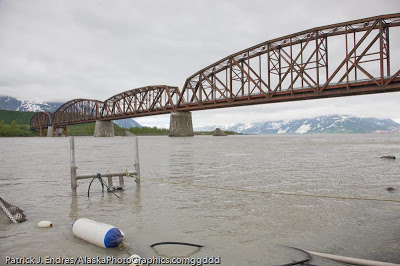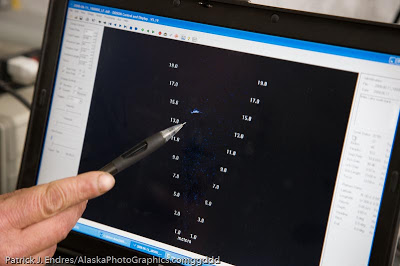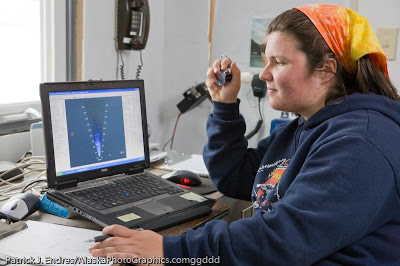 Miles lake sonar station located along the Copper River near the historic Million Dollar Bridge. Submersed sonar transmits visual data to computer terminals enabling technicians to count fish passing by.
Miles lake sonar station located along the Copper River near the historic Million Dollar Bridge. Submersed sonar transmits visual data to computer terminals enabling technicians to count fish passing by.
The commercial fisheries management procedure is a complicated one. Mainly because there are so many factors that can influence the health of a salmon run in any given year. Remember, there are at least 156 different stocks of red salmon that run up the Copper River, branching off here and there at the respective waters of their youth. They return five years after birth, so climatic and other factors for that year must be considered in the current year of their return. The Alaska Department of Fish and Game wants to see a certain amount of the fish make it past the fisherman in order to sustain the natural stocks. To prevent too many fish from being caught, the season openings are based on the amount of fish that have passed on up the river. How is this known? Through a fancy sonar counting system set up a short ways up the Copper River. Sophisticated sonar lets one actually see the fish swimming up the river.
 Salmon appear as white shapes swimming by the sonar field.
Salmon appear as white shapes swimming by the sonar field.
ADF&G staff record a 10 minute digital movie file generated by the sonar and then count the fish that have passed by in that time period (one can count the fish with live sonar display on computer screens as well, but a digital file enables speed adjustment to aid in counting accuracy).
 ADF&G technician counts salmon passing by the sonar field for a ten minute period every hour.
ADF&G technician counts salmon passing by the sonar field for a ten minute period every hour.
Based on that, a fish-per-hour count is generated, and total daily “escapement” numbers are posted on the ADFG Miles Lake sonar counts page. The system has been through statistical rigors and seems to satisfy the biometricians. For the dip netters waiting for these fish to reach the Chitina dip netting area, it takes approximately 10 to 14 days from the Miles Lake sonar station.






